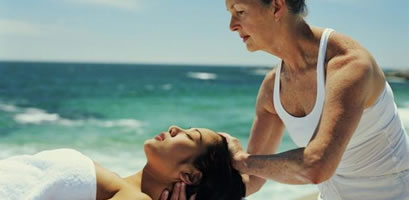Massage : Basic Techniques of Swedish Massage
Traditional Swedish Massage uses five main strokes, and many variations, to achieve its relaxing and healing effects. Many therapists use a variety of techniques.
Effleurage consists of long, gliding strokes from the neck down to the base of the spine or from the shoulder down to the fingertips. When done on the limbs, all strokes are toward the heart to aid blood and lymphatic flow. It is done with the whole hand or the thumb pads. Effleurage is designed to acquaint the therapist with his or her subject's body and vice versa.
Petrissage involves gently lifting muscles up and away from the bones, then rolling and squeezing them, again with a gentle pressure. It generally involves kneading and compression motions - rolling, squeezing, or pressing the muscles to enhance deeper circulation. Petrissage attempts to increase circulation with clearing out toxins from muscle and nerve tissue.
Friction is the most penetrating of the strokes, and consists of deep circular or transverse movements made with the thumb pads or fingertips. The therapist applies deep, circular movement near joints and other bony areas (such as the sides of the spine). Friction breaks down adhesions, which are knots that result when muscle fibers bind together during the healing process, thus contributing to more flexible muscles and joints.
Tapotement consists of a series of briskly applied percussive movements, using the hands alternately to strike or tap the muscles for an invigorating effect. There are many variations on this stroke. It may be applied with the edge of the hand, with the tips of the fingers, or with a closed fist. Tapotement attempts to release tension and cramping from muscles in spasm.
Vibration, or Shaking, involves the therapist pressing his or her hands on the back or limbs, and rapidly shaking for a few seconds. It boosts circulation and increase the power of the muscles to contact. Vibration is particularly helpful to people suffering from low-back pain.







